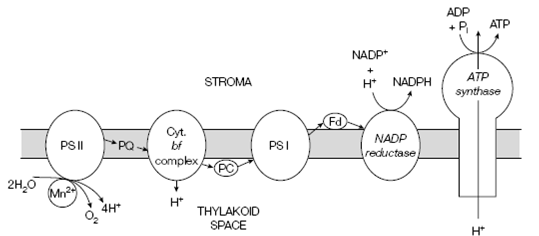Noncyclic photophosphorylation:
During operation of the Z scheme, high-energy electrons are created through energy- input through the two photosystems and the electrons then travel along a chain of carriers which reduce in redox potential shown in the below figure. This is analogous to the passage of electrons along the respiratory chain in mitochondria. In a additional analogy, the cytochrome bf complex is a proton pump and pumps H+ ions from the stroma into the thylakoid space. Thus an H+ gradient is

Figure: Formation of the proton gradient and ATP synthesis
formed during electron transport. Because of the orientation of the various electron transport components in the thylakoid membrane the H+ ions released when PSII oxidizes water to produce oxygen are released into the thylakoid space whilst the H+ used to decrease NADP+ to NADPH through NADP reductase are taken up from the stroma. Therefore these two reactions also contribute to the proton gradient. A proton gradient drives ATP synthesis through an ATP synthase situated in the thylakoid membrane. This is known as photophosphorylation and is analogous to ATP synthesis through a proton gradient during oxidative phosphorylation in mitochondria. The difference is in which protons are pumped out of mitochondria but into a sub compartment and the thylakoid space, in chloroplasts. Because of the other (cyclic) pathway for electron transport and ATP synthesis, the creation of ATP through the joint operation of PSI and PSII is known as noncyclic photophosphorylation.